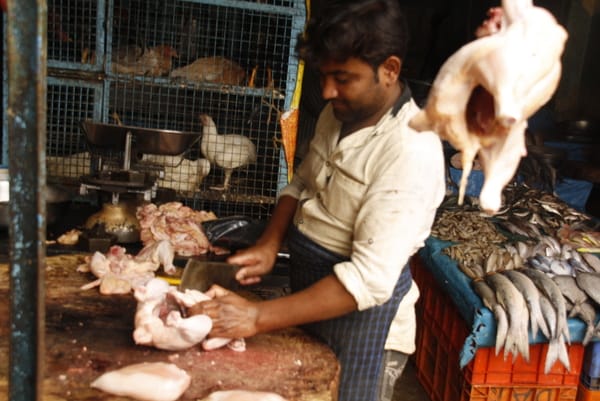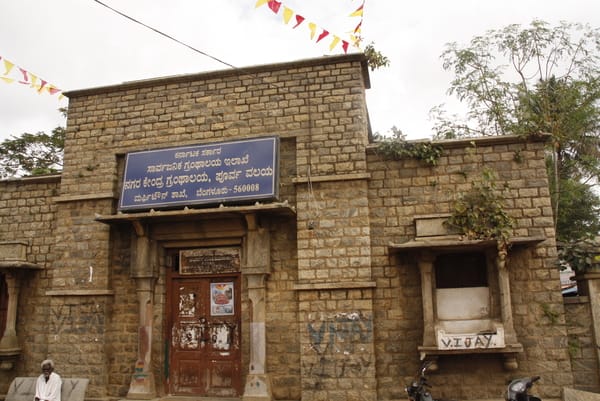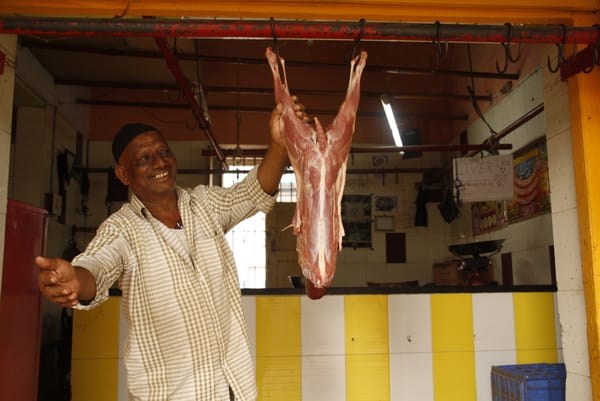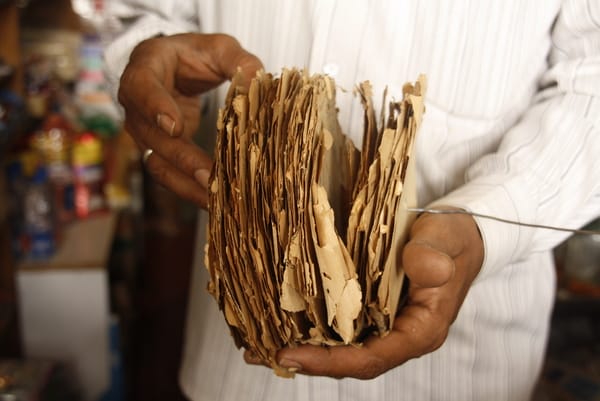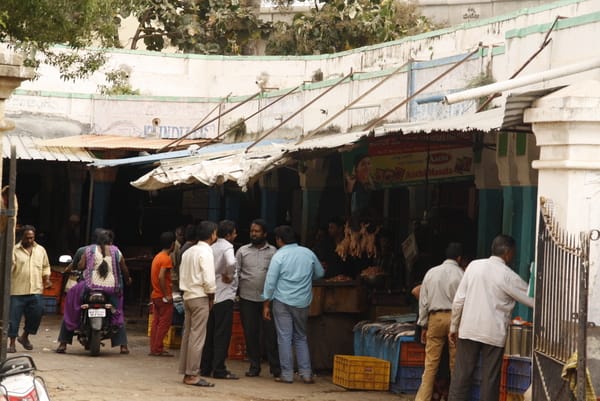A butcher at the Murphy Town market showing off his skill with a cleaver. Pic: Pavan Kulkarni
Murphy Town market, along with Johnson market and Russell market, may be officially declared as heritage structures in the near future. Professor Gitanjali Rao, the director of Art, Architecture, Design Environment Consultants (AEDI), a Hubli-based organisation designated by the Archaeology Department with the task of preparing a list of heritage structures in Bengaluru, has confirmed to Citizen Matters that Murphy town market is one of the 800+ entries in their initial inventory of heritage structures in Bengaluru.
However, operating under tight time constraints, AEDI has not been able to secure the on-site architectural documentation containing information on its present status and on how much of the structure’s original character has been retained.
Once all the required documentation is complete, another round of discussion involving all the stakeholders in government and the civil society is to be held. Following this, the list will be finalised and introduction of suitable measures to conserve, and wherever necessary, to restore these heritage structures will be considered.
There is no officially declared heritage structure in Bengaluru yet. This is the first such project to document heritage structures of Bengaluru.
Yet another memory of British colonies in Bengaluru
An old public library at Murphy Town market. Pic: Pavan Kulkarni
With two east-facing entrances on either side of the public library – a single storied stone-building in the centre with a high ceiling – Murphy town market has four stalls selling fish, six poultry stalls and two stalls for mutton. Two stalls sell beef in a separate section behind a segregating wall towards the rear end.
Butcher at the mutton stall, happy to display fresh meat. Pic: Pavan Kulkarni
A separate section for beef. Pic: Pavan Kulkarni
Until about a decade ago, the market also had some stalls selling vegetables. But since most vegetarian customers preferred buying vegetables outside the meat market, the vegetable vendors who were previously selling here, have now set up small shops on the lane adjoining the northern wall of the market.
Citizen Matters spoke to Abdul Haleem, the secretary of the traders’ union of Murphy-town market, who owns the only departmental store in this meat bazaar, in December 2014. According to him, the structure was built almost a century ago to cater to the needs of the servants, cleaners and other menial workers hired by the British, who were living in this area.
Originally named Knoxpet, after the then councillor, Stuart George Knox, this area was renamed in 1937 by the then British Resident of Mysore, as Murphy-town, in recognition of the architect and engineer, W H Murphy, who made a significant contribution in improving the sanitary conditions in this area by setting up an underground drainage system.
The times when rent was Rs 1.5
“My grandfather, Abdul Shukoor, was the first person to be allotted a shop here,” says Abdul Haleem, with considerable pride. “Initially, he used to pay around one rupee and fifty paise as rent. Today the common rent is fixed at Rs 110. There has been no increase for the last 10 or 15 years,” he adds.
However, every time a shop is transferred from one party to another – say, if Haleem transfers the ownership of this stall to his son—the rent doubles. Because of this, shop no. 15 pays around Rs 1,000 as rent every month. Most shops are 8 feet by 10 feet. The ones in the corner are slightly bigger, but the rent does not vary with size.
Abdul Haleem flaunts a bundle of old receipts of rents paid since his grandfather’s time. Pic: Pavan Kulkarni
“We have never defaulted on a single month’s rent. You can check for yourself,” he says, handing over bundle of hundreds of old receipts, with fading letters on old brownish-yellow paper.
A receipt on the 6 rupees and 37 paise paid as rent for his shop in 1959. Pic: Pavan Kulkarni
He adds, “I have carefully saved all the receipts for rent payments made since the mid-1970s. All the other shopkeepers had saved their receipts as well. But when this place was lit up by a mob sometime in the early 90s, many lost their receipts to fire. Mine was the only shop that was not burnt,” recalling the tragic incident.
Memory of fire still haunts the traders
“There was a political rally held in the ground at the end of the street behind,” Haleem says pointing at the southern wall of the market. “Some of them came inside and requested us to close the market for one day because it was a religious gathering. It was a Sunday, the day when we get the best business. But we did not want to hurt anyone’s religious sentiments by selling meat, so we closed the market that day and went home.”
“But when we were gone, they took advantage of our absence and set the market on fire. We lodged an FIR, but no action was taken against that mob,” Haleem complains. “Neither did we receive any compensation from the government.”
He adds, “Luckily, this is market is an all stone structure and hence not much damage was done. We had to get the place repainted and some of the wooden shutters that were completely burnt down had to be replaced by new steel shutters. It cost us around Rs 30,000 altogether. With the help of some well-wishers, we raised the amount and got the work done without any help from the government.”
Lack of municipal services
There is no electricity supply from BESCOM to this market. Power is bought privately. Each stall here has a separate electric meter, and the electricity bill ranges from Rs 150 in the small butcher stalls to Rs 800 in those having a fridge or cold storage facility.
“We have no water supply either. The shop-keepers fill water in drums from the water-tank beside the market, and store it inside their stalls,” says Haleem.
When asked about toilet facilities, he says that they are fed up of requesting the government to build one in the market. He adds: “There has never been a toilet here since the time this place was built. The 60-70 people who work here everyday have to walk 5 minutes to the pay and use toilets every time.”
The BBMP collects garbage every morning. The BBMP does not collect non-vegetable waste separately from anywhere in Bengaluru. Sources say there is a private arrangement costing Rs 50 a month to each shopkeeper.
“For whom will the mall be built?”
In December 2014, BBMP had planned to renovate the Murphy Town market. This decision had aggrieved the shoppers, who said they had not received any official notice from the government, but only read in newspapers that BBMP is planning to raze down the place and build a mall.
The move to build a mall was absurd according to Mehaboob, who works in the shop owned by Abdul Haleem. “For whom will the mall be built? Have you seen the place around here? Most people in this area are poor, living hand-to-mouth. Many of our customers buy 100 grams of meat for 10-15 rupees. Can they do that in a mall?” he questions.
Loyal customers flock to the market each morning. Pic: Pavan Kulkarni
“Far from being able to afford to buy anything in a mall, these poor people here are afraid to even step inside such a place. Malls have to be built in areas where affordability of the population is high. For this area, this market is perfect,” adds Haleem, requesting us to ask the government to not put the livelihoods of so many vendors and the affordability of basic food of so many people in danger.
He also feels that if the government could spend a fraction of the amount needed to build the mall, on providing toilet facilities and running water supply inside the market, the facility would become much more consumer-friendly.
Two months after our visit to this market, the BBMP market committee chairman, Nanjundappa, has confirmed to Citizen Matters that Murphy town market has been dropped from the list of 18 markets it had prepared for redevelopment.
“It is a stone-building. The structure is still strong. There is no need to redevelop this market,” he said.
Related Articles
Bengaluru’s markets: Going, going, gone?
The ordinary & the everyday : street corners at Russell market
Citizens ask BBMP to save Bengaluru’s heritage markets
Heritage walk around Cubbonpet Market offers a peek into old Bengaluru
